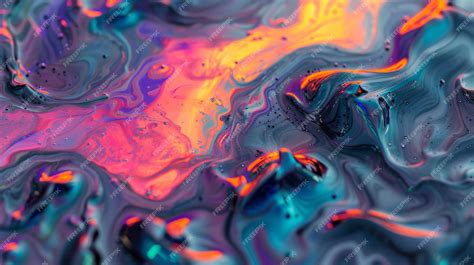The captivating world of oil slicks unveils a breathtaking array of colors that dance upon the water’s surface. These iridescent hues, a result of light interference, create an ethereal spectacle that has enchanted artists, scientists, and environmentalists alike.

Physics Behind the Phenomenon
Oil slicks are formed when oil spills or leaks into water. The oil, being less dense than water, floats on the surface and spreads out into a thin layer. When sunlight hits this layer, it undergoes a complex interaction with the molecules within the oil. As the light waves travel through the oil, they bounce back and forth between the air-oil interface and the oil-water interface. This multiple reflection causes constructive and destructive interference, resulting in the vibrant colors we observe.
Diversity of Colors
The colors of an oil slick vary based on the thickness of the oil layer, the angle of the sunlight, and the wavelength of light. Thin layers typically produce a rainbow-like spectrum, with blues and greens predominating. As the layer thickens, the colors shift towards the red end of the spectrum. Additionally, the angle of the sunlight affects the intensity and hue of the colors, with lower angles producing brighter and more saturated hues.
Measurement Methods
Scientists have developed various methods to measure the thickness of oil slicks based on their color. One common technique is to use a spectrometer, which measures the intensity of light at different wavelengths. By analyzing the spectrum, researchers can determine the thickness of the oil layer. Another method involves capturing images of the oil slick using a camera equipped with a special filter that isolates specific wavelengths of light.
Environmental Significance
Oil slicks are not merely aesthetic phenomena; they have profound environmental implications. The presence of oil on water surfaces can disrupt the ecosystem, affecting marine life, birds, and coastal habitats. Oil slicks can block sunlight from reaching underwater organisms, reducing photosynthesis and phytoplankton growth. They can also contaminate the water column and sediment, affecting the health of fish and other marine creatures.
Applications and Inspirations
Despite their environmental concerns, the iridescent colors of oil slicks have inspired numerous applications and creations. Scientists are exploring ways to harness the light-bending properties of oil slicks in novel optical devices, such as thin-film coatings and waveguides. Artists have incorporated oil slick colors into their paintings, sculptures, and installations, capturing the beauty and allure of these iridescent hues.
Creating Oil Slick Colors for Products
The vibrant colors of oil slicks have also found their way into commercial products. Manufacturers have developed paints, textiles, and plastics that emulate the iridescent sheen of oil slicks. These materials are being used in various applications, including fashion, home décor, and automotive design.
Color Consistency
To ensure color consistency and quality in oil slick-inspired products, manufacturers often rely on color measurement instruments. These instruments accurately capture the spectral characteristics of the materials, enabling precise color matching and control.
Tips and Tricks for Creating Oil Slick Colors
For those looking to incorporate oil slick colors into their own creations, here are a few tips:
- Use thin layers of paint or material to create a rainbow-like effect.
- Experiment with different angles of light to achieve varying hues.
- Consider the thickness of the oil slick and the desired color outcome.
- Use a spectrometer or other color measurement tool to ensure color accuracy.
Conclusion
The mesmerizing oil slick colors are a testament to the intricate interplay of light and matter. Their iridescent beauty has captivated observers throughout history, inspiring art, science, and innovation. As we continue to explore the potential applications of these colors, we must also remain mindful of their environmental significance and strive to minimize their impact on our planet.
